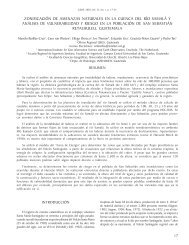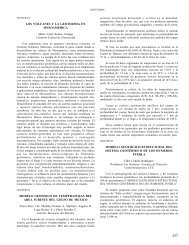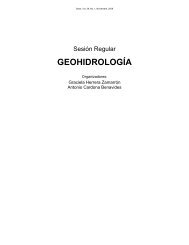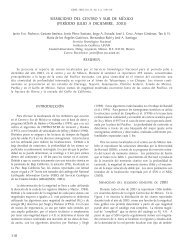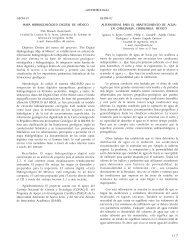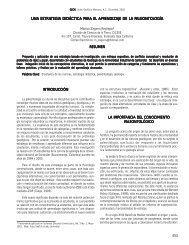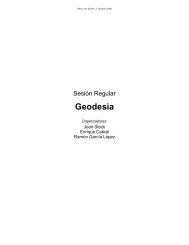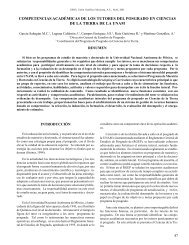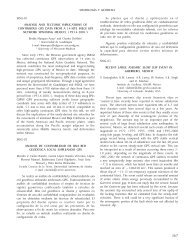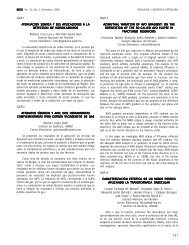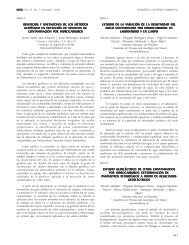SISMOLOGÍA Geos, Vol. 31, No. 1, Noviembre, 2011SIS-10SIS-12ESTIM<strong>AC</strong>IÓN RÁPIDA DE LOS PARÁMETROS DE FUENTE ESENCIALESPARA UNA ALERTA TEMPRANA DE TSUNAMIS CON REDESGPS A LO LARGO DE LA COSTA: UN ESTUDIO DE VIABILIDADSingh Shri Krishna 1 , Pérez-Campos Xyoli 1 , IglesiasMendoza Arturo 1 y Melgar Moctezuma Diego 21 Instituto <strong>de</strong> Geofísica, UNAM2 Scripps Institution of Oceanography, UCSD, USAkrishna@ollin.igeofcu.unam.mxPonemos a prueba la viabilidad <strong>de</strong> la estimación rápida <strong>de</strong> la longitud <strong>de</strong> laruptura, la ubicación <strong>de</strong> la proyección <strong>de</strong>l bor<strong>de</strong> inferior <strong>de</strong>l área la rupturacon respecto a la costa, y Mw <strong>de</strong> terremotos gran<strong>de</strong>s <strong>de</strong> subducción, usandovectores <strong>de</strong> <strong>de</strong>splazamiento cosísmico estático <strong>de</strong> estaciones GPS a lo largo<strong>de</strong> la costa, cercanas a las trincheras. Es necesario un conocimiento a priori <strong>de</strong>la geometría <strong>de</strong> la interfaz <strong>de</strong> la placa, la extensión <strong>de</strong> la zona sismogénica y laprofundidad máxima <strong>de</strong>l acoplamiento. Nuestro análisis se basa en la solución<strong>de</strong> Okada (1992) para el <strong>de</strong>splazamiento <strong>de</strong> la superficie <strong>de</strong>bido a una fallarectangular en un semiespacio. La longitud <strong>de</strong> la ruptura, L, se calcula a partir<strong>de</strong> la amplitud <strong>de</strong>l <strong>de</strong>splazamiento horizontal observada a lo largo <strong>de</strong> la costa ysu caída con la distancia. El límite <strong>de</strong> la ruptura se estima a partir <strong>de</strong>l sentido <strong>de</strong><strong>de</strong>splazamiento vertical. El ancho W se calcula utilizando el siguiente criterio:si L > Ws entonces W = Ws, pero si L < Ws entonces W = L, don<strong>de</strong> Ws es elancho <strong>de</strong> la zona sismogénica. En nuestras pruebas suponemos un echado <strong>de</strong>15° y un <strong>de</strong>slizamiento uniforme puramente inverso (rake 90°). El <strong>de</strong>slizamientoen la falla, D, se calcula utilizando el mo<strong>de</strong>lo <strong>de</strong> Okada, <strong>de</strong> manera que está<strong>de</strong> acuerdo con el promedio <strong>de</strong> <strong>de</strong>splazamiento horizontal observado a lo largo<strong>de</strong> la costa sobre L. Por último, el momento sísmico se calcula a partir <strong>de</strong> M0= µLWD.Aplicamos el método propuesto a la <strong>de</strong>formación cosísmica reportada <strong>de</strong> nuevesismos: Colima-Jalisco, México 1995 (Mw8.0); Tecomán, México 2003 (Mw7.3);Hokaido, Japón 2003 (Mw8.3) y su réplica (Mw7.3); Sumatra 2004 (Mw9.2);Nias 2005 (Mw8.6); Maule, Chile 2010 (Mw8.8); Tohoku, Japón 2011 (Mw9.1)y su réplica (Mw7.9). La Mw estimada es robusta y 0.2, en promedio, <strong>de</strong> laregistrada en el catálogo GCMT en todos los casos. La L estimada y la ubicación<strong>de</strong>l bor<strong>de</strong> inferior <strong>de</strong> la ruptura están <strong>de</strong> acuerdo en general con los reportadosen estudios <strong>de</strong>tallados. Con información en tiempo real <strong>de</strong> los <strong>de</strong>splazamientosen los sitios GPS, es posible obtener una estimación robusta <strong>de</strong> los parámetroscríticos <strong>de</strong> la fuente en < 5 min. El método es simple, robusto, y no asumeuna fuente puntual. También proporciona la longitud <strong>de</strong> la ruptura. Por lo tanto,ofrece algunas ventajas sobre la estimación <strong>de</strong> Mw con fase W.SIS-11SOURCE SCALING RELATIONSHIP OF MEXICAN SUBDUCTIONEARTHQUAKES FOR THE PREDICTION OF STRONG GROUND MOTIONSRamírez Gaytan Gonzalo Alejandro 1 , Huerta López CarlosIsidro 2 , Aguirre González Jorge 3 y Rosado Trillo Cecilia 11 Centro Universitario <strong>de</strong> Ciencias Exactas e Ingenierías, UDG2 División <strong>de</strong> Ciencias <strong>de</strong> la Tierra, CICESE3 Instituto <strong>de</strong> Ingeniería, UNAMgramirez@sciences.sdsu.eduIn the past several years many studies have been carried out to investigatethe source scaling of earthquakes. The relationships generated in these studiesprovi<strong>de</strong> a way to un<strong>de</strong>rstand the mechanics of the rupture, also give <strong>de</strong>terministicparameters in the prediction of strong ground motions. A quantitative criterion forextracting source parameters from large subduction earthquakes was proposedby Somerville et al. (2002). In recent years some authors was conducted studiesto simulate big earthquakes in Mexico by using empirical Green’s functionmethod. The source parameters generated in these simulations show pooradjust when comparing with Somerville et al. (2002) relations. The fit in somecases are minor to 27% respect to proposed in these relations. This mightsuggests that not all of the relationships proposed by Somerville et al. (2002)are applicable to the subduction zone in Mexico. In this study we constructthe scaling relationship of the source parameters for Mexico subduction zone.We compiled slips mo<strong>de</strong>ls of large earthquakes in Mexico from kinematic slipmo<strong>de</strong>ls <strong>de</strong>veloped by several investigators. Our objectives is ma<strong>de</strong> a comparisonbetween this new relations that use data from Mexican subduction earthquakesand Somerville et al. (2002) that use data from large subduction word wi<strong>de</strong>earthquakes. The comparison between both relations compared here, showsthat relationships proposed in this study are shorter than relations proposed bySomerville et al. (2002). The results of this study might explain the obtained inthe simulation of big earthquakes in Mexico.ANISOTROPÍA DE LA ONDA SKS EN EL MANTOSUPERIOR DEBAJO DEL ARREGLO MASE Y LAS NUEVASEST<strong>AC</strong>IONES DEL SERVICIO SISMOLÓGICO N<strong>AC</strong>IONALRojo Garibaldi Berenice 1 , Ponce Cortés Gustavo 2 , ValenzuelaWong Raúl 3 , Stubailo Igor 4 , Davis Paul 5 , Husker Allen 3 ,Pérez-Campos Xyoli 3 , Iglesias Mendoza Arturo 3 y Clayton Robert W. 61 Facultad <strong>de</strong> Ciencias, UNAM2 Facultad <strong>de</strong> Ingeniería, UNAM3 Instituto <strong>de</strong> Geofísica, UNAM4 Department of Earth and Space Sciences, UCLA5 Earth and Space Sciences, UCLA6 Division of Geological and Planetary Sciences, California Institute of Technology, USAbendscuevas@gmail.comCalculamos los parámetros que <strong>de</strong>scriben la anisotropía <strong>de</strong>l manto superior<strong>de</strong>bajo <strong>de</strong> estaciones <strong>de</strong> banda ancha usando registros <strong>de</strong> ondas SKS. Losparámetros que se usan para cuantificar la anisotropía son el tiempo <strong>de</strong> retardo(dt) y la dirección <strong>de</strong> polarizacion <strong>de</strong> máxima velocidad (fi). La anisotropía secalcula con la técnica <strong>de</strong> Silver y Chan [1991]. Se escoge un segmento <strong>de</strong>tiempo que contenga a la onda SKS en las componentes norte-sur y este-oeste.A continuación se hace una búsqueda en el espacio <strong>de</strong> posibles solucionesvariando fi entre valores <strong>de</strong> -90 y 90 grados. Se rotan los ejes coor<strong>de</strong>nadosen incrementos <strong>de</strong> 1 grado. Por cada valor <strong>de</strong> fi que se prueba, se exploratambién el espacio <strong>de</strong> tiempos <strong>de</strong> retardo en incrementos <strong>de</strong> 0.05 s y secalculan la autocorrelación y la correlación cruzada <strong>de</strong> las dos componentes. Secalculan los valores característicos que correspon<strong>de</strong>n a cada combinación <strong>de</strong>dt y fi. Como los registros también contienen ruido, la solución buscada vienedada por la matriz que sea más cercana a la matriz singular. Para checar losresultados se aplica una corrección a los registros originales con los valoresobtenidos <strong>de</strong> dt y fi y se rotan para comprobar que los parámetros medidospue<strong>de</strong>n eliminar la anisotropía. A fin <strong>de</strong> asegurarse que el resultado obtenidoes confiable, se comparan las formas <strong>de</strong> onda y las diferencias en el tiempo <strong>de</strong>llegada para las ondas rápida y lenta. Como una comprobación más, se graficala polarización <strong>de</strong>l movimiento radial y transversal <strong>de</strong> las partículas antes y<strong>de</strong>spués <strong>de</strong> aplicar la corrección. Se utilizaron registros <strong>de</strong>l perfil Meso-AmericanSubduction Experiment (MASE) el cual consistió <strong>de</strong> 100 estaciones en lasentida<strong>de</strong>s <strong>de</strong> Guerrero, Morelos, Distrito Fe<strong>de</strong>ral, Hidalgo y Veracruz. Estearreglo operó <strong>de</strong> 2005 a 2007 [Pérez Campos et al., 2008]. A<strong>de</strong>más se usaronlas nuevas estaciones <strong>de</strong>l Servicio Sismológico Nacional (SSN) instaladas apartir <strong>de</strong> 2005 [Valdés González et al., 2005]. En el sur <strong>de</strong>l arreglo el eje rápido<strong>de</strong> la anisotropía se orienta aproximadamente NE-SO (N41°E en promedio)y el tiempo <strong>de</strong> retardo es <strong>de</strong> 0.90 s en promedio. Este patrón es consistente<strong>de</strong>s<strong>de</strong> Acapulco hasta unos kilómetros al sur <strong>de</strong> la Ciudad <strong>de</strong> México y coinci<strong>de</strong>con la región don<strong>de</strong> la placa <strong>de</strong> Cocos se subduce subhorizontalmente [PérezCampos et al., 2008]. El eje rápido concuerda con el movimiento relativo entrelas placas Cocos-Norteamérica y es aproximadamente perpendicular a la FosaMesoamericana. En la parte norte <strong>de</strong>l perfil el dt es pequeño indicando quehay poca anisotropía. La orientación <strong>de</strong> fi no está tan claramente <strong>de</strong>finida perose observa una rotación <strong>de</strong>l eje rápido hacia las direcciones N-S y NNO-SSE.Este régimen se observa don<strong>de</strong> la placa <strong>de</strong> Cocos cambia abruptamente auna subducción más inclinada [Pérez Campos et al., 2008; Husker y Davis,2009] y <strong>de</strong> hecho continúa más al norte. La anisotropía observada en MASE esconsistente con las estaciones <strong>de</strong>l SSN [Van Benthem, 2005; Van Benthem yValenzuela, 2007; este trabajo].SIS-13THE MANTLE TRANSITION ZONE BENEATH MEXICOPérez-Campos Xyoli 1 y Clayton Robert W. 21 Instituto <strong>de</strong> Geofísica, UNAM2 Division of Geological and Planetary Sciences, California Institute of Technology, USAxyoli@geofisica.unam.mxMexico is a diverse natural tectonic laboratory. Two of the most prominentfeatures are the formation of new oceanic floor in the northwest (Gulf ofCalifornia), and the subduction of Rivera and Cocos plates un<strong>de</strong>rneath NorthAmerican plate in central and southern Mexico. The presence of such tectonicfeatures affects the composition and thermal state of the upper mantle, whichin turn are reflected as seismic signatures that can be analyzed by means ofP-wave receiver functions.We study the upper mantle transition zone characteristics for both regions (Gulfof California and central-southern Mexico) in or<strong>de</strong>r to get a better un<strong>de</strong>rstandingof the upper mantle dynamics and plate tectonics in the region. Along the Gulfof California we can distinguish three regions that can be interpreted in terms ofwater presence, <strong>de</strong>limitating the presence of the remaining Farallon slab and theslab tear. In central-southern Mexico, preliminary results show the interaction ofthe Cocos slab with the 410, but not the 660 discontinuities in central Mexico.116
Geos, Vol. 31, No. 1, Noviembre, 2011SISMOLOGÍASIS-14TOMOGRAFÍA SÍSMICA DE ALTA RESOLUCIÓN Y ESTRUCTUR<strong>AC</strong>ORTICAL DE LA ZONA CENTRO-SUR DEL ESTADO DE VER<strong>AC</strong>RUZCórdoba Montiel Francisco 1 , Iglesias Mendoza Arturo 2 , Singh ShriKrishna 2 , Torres Morales Gilbert Francisco 1 y Mora González Ignacio 11 Centro <strong>de</strong> Ciencias <strong>de</strong> la Tierra, UV2 Instituto <strong>de</strong> Geofísica, UNAMfcordoba@uv.mxSe presentan los resultados obtenidos a partir <strong>de</strong>l cálculo <strong>de</strong> las correlacionescruzadas <strong>de</strong> ruido entre pares <strong>de</strong> estaciones para la obtención <strong>de</strong> unatomografía <strong>de</strong> la zona centro-sur <strong>de</strong>l Estado <strong>de</strong> Veracruz con datos que incluyena la re<strong>de</strong>s <strong>de</strong>l Servicio Sismológico Nacional, el proyecto VEOX y <strong>de</strong> un arreglotemporal que operó en la ciudad <strong>de</strong> Xalapa. Para el procesamiento <strong>de</strong> datosse utilizaron registros <strong>de</strong> ruido <strong>de</strong> las diferentes re<strong>de</strong>s que contribuyen a larealización <strong>de</strong> este estudio, se extrajo la función <strong>de</strong> Green entre pares <strong>de</strong>estaciones a partir <strong>de</strong> correlaciones cruzadas <strong>de</strong> series largas <strong>de</strong> tiempo paraposteriormente obtener curvas <strong>de</strong> dispersión <strong>de</strong> ondas superficiales (velocidad<strong>de</strong> grupo <strong>de</strong> ondas <strong>de</strong> Rayleigh) a través <strong>de</strong>l método <strong>de</strong> filtrado múltiple(Dziewonski et al., 1969). A<strong>de</strong>más, se realizó un ejercicio <strong>de</strong> tomografíasísmica para varios periodos utilizando un algoritmo <strong>de</strong> regionalización continua(Debayle y Sambridge, 2004) para invertir el conjunto <strong>de</strong> velocida<strong>de</strong>s <strong>de</strong> grupopor cada periodo.Con el objeto <strong>de</strong> incrementar la resolución <strong>de</strong>l estudio, también se utilizarondatos <strong>de</strong>l Proyecto MASE <strong>de</strong> acuerdo con un estudio realizado por Iglesias etal. (2010), lo cual permitió disponer <strong>de</strong> una mayor <strong>de</strong>nsidad <strong>de</strong> estaciones ytrayectorias para la obtención <strong>de</strong> la tomografía sísmica regional.De forma complementaria, se llevó a cabo la <strong>de</strong>terminación <strong>de</strong> las funcionesreceptor para algunas estaciones <strong>de</strong>l arreglo <strong>de</strong> Xalapa utilizando datostelesísmicos. Esto permitió la comparación <strong>de</strong> resultados entre estaciones muycercanas entre sí y el análisis <strong>de</strong> la <strong>de</strong>pen<strong>de</strong>ncia azimutal. Este ejerciciose efectuó también para una estación temporal localizada a 5 km <strong>de</strong> lazona epicentral <strong>de</strong>l sismo <strong>de</strong>l 3 <strong>de</strong> enero <strong>de</strong> 1920 (M ~ 6.4). Los resultadosobtenidos mediante funciones receptor y análisis <strong>de</strong> ruido se aprovecharon para<strong>de</strong>sarrollar la inversión conjunta y obtener con ello un mo<strong>de</strong>lo <strong>de</strong> estructura <strong>de</strong>velocida<strong>de</strong>s en la zona <strong>de</strong> estudio.SIS-15ANISOTROPÍA SÍSMICA DE ONDAS SLOCALES EN EL ISTMO DE TEHUANTEPECLeón Soto Gerardo 1 , González López Adriana 2 , Valenzuela Wong Raúl 3 ,Pérez-Campos Xyoli 3 , Iglesias Mendoza Arturo 3 y Clayton Robert W. 41 Facultad <strong>de</strong> Ciencias Físico Matemáticas, UMSNH2 Facultad <strong>de</strong> Ingeniería, UNAM3 Instituto <strong>de</strong> Geofísica, UNAM4 Division of Geological and Planetary Sciences, California Institute of Technology, USAgleon@umich.mxCalculamos los parámetros que <strong>de</strong>scriben la anisotropía sísmica <strong>de</strong> la cuña<strong>de</strong>l manto usando ondas S originadas en la placa <strong>de</strong> Cocos subducida en laregión <strong>de</strong>l Istmo <strong>de</strong> Tehuantepec. Dichos parámetros son el tiempo <strong>de</strong> retrasoy la dirección <strong>de</strong> polarización rápida. Los datos utilizados fueron registros <strong>de</strong>lperfil Veracruz-Oaxaca (VEOX) así como <strong>de</strong> la red permanente <strong>de</strong> bandaancha <strong>de</strong>l Servicio Sismológico Nacional (SSN). El experimento temporal VEOXestuvo compuesto <strong>de</strong> 46 estaciones <strong>de</strong> banda ancha a lo largo <strong>de</strong>l Istmo <strong>de</strong>Tehuantepec, <strong>de</strong> norte a sur, estuvo en operación <strong>de</strong>s<strong>de</strong> mediados <strong>de</strong> 2007hasta mediados <strong>de</strong> 2009. Los resultados obtenidos muestran tiempos <strong>de</strong> retraso<strong>de</strong> hasta 0.6 seg consistentes con una <strong>de</strong>pen<strong>de</strong>ncia en la profundidad. Lasdirecciones <strong>de</strong> polarización rápida muestran un patrón normal a la geometría <strong>de</strong>la subducción para profundida<strong>de</strong>s mayores a 100 km. A profundida<strong>de</strong>s menoresa 100 km el patrón en las direcciones <strong>de</strong> polarización rápida es más oblicuo a lasubducción y en los tiempos <strong>de</strong> retraso alcanzan hasta 0.4 seg. Estos resultadosson consistentes con un “corner flow” en la cuña <strong>de</strong>l manto. Las mediciones <strong>de</strong>anisotropía para el extremo sur <strong>de</strong>l perfil recorren trayectorias más cortas en lacuña <strong>de</strong>l manto o trayectorias en la corteza continental <strong>de</strong> América <strong>de</strong>l Norte casiexclusivamente. Por lo tanto estas mediciones indican que la dirección rápidaestá orientada aproximadamente este-oeste y reflejan prepon<strong>de</strong>rantemente elefecto <strong>de</strong> la corteza continental.SIS-16IMÁGENES SÍSMICAS DE LA CORTEZA A LO LARGO DE LATRANSECTA: CRESTA DE BEATA-LA ESPAÑOLA-PLATAFORMADE LAS BAHAMAS (BORDE NE DE LA PL<strong>AC</strong>A CARIBE)Núñez Escribano Diana 1 , Córdoba Barba Diego 1 y Pazos Antonio 21 Facultad <strong>de</strong> Ciencias Físicas, Universidad Complutense <strong>de</strong> Madrid, España2 Real Instituto y Observatorio <strong>de</strong> la Armada, San Fernando, Cádiz, Españadianane@fis.ucm.esLa región <strong>de</strong>l Mar Caribe y La Española ha sido objeto <strong>de</strong> diferentes estudiosen los últimos años <strong>de</strong>bido a su interés tectónico y geológico relacionado conprocesos <strong>de</strong> subducción, colisión y <strong>de</strong>sgarres laterales. En el bor<strong>de</strong> NE <strong>de</strong>la placa Caribe, el arco <strong>de</strong> isla <strong>de</strong> La Española colisiona con el Banco <strong>de</strong>Las Bahamas produciendo una ralentización o interrupción <strong>de</strong>l proceso <strong>de</strong>subducción <strong>de</strong>bido a su comportamiento rígido. En la parte Sur <strong>de</strong> La Española,la Cresta <strong>de</strong> Beata colisiona con esta isla, emergiendo en su parte interior, enla Sierra <strong>de</strong> Bahoruco, con una anchura aproximada <strong>de</strong> 100 km. En el sur, laCresta <strong>de</strong> Beata se localiza por <strong>de</strong>bajo <strong>de</strong>l nivel <strong>de</strong>l mar, con una extensiónaproximada <strong>de</strong> 350 km.En los últimos cinco años se han llevado a cabo dos investigaciones geofísicas,GEOPRICO (2005) y CARIBE NORTE (2009), con el objetivo principal <strong>de</strong>estudiar la estructura profunda <strong>de</strong> la corteza en el bor<strong>de</strong> NE <strong>de</strong> la Placa Caribe,<strong>de</strong>s<strong>de</strong> la Cresta <strong>de</strong> Beata (República Dominicana) hasta el Pasaje <strong>de</strong> Anegada(Antillas Menores) así como la <strong>de</strong>terminación <strong>de</strong> posibles correlaciones entrelas características tectónicas observadas en el interior <strong>de</strong> la Española y lasestructuras situadas en las regiones marinas colindantes.En el marco <strong>de</strong> esos estudios, se presentan los resultados más significativos<strong>de</strong> un perfil sísmico profundo mar-tierra <strong>de</strong> 400 km <strong>de</strong> longitud, realizado enel proyecto CARIBE NORTE (perfil A) que atraviesa la República Dominicanaen su parte occi<strong>de</strong>ntal, siguiendo una alineación SO-NE. Este perfil estáconfigurado por una red <strong>de</strong> 101 estaciones sísmicas terrestres <strong>de</strong>splegadas aintervalos <strong>de</strong> 2 km, <strong>de</strong>s<strong>de</strong> Pe<strong>de</strong>rnales hasta Puerto Plata y 3 OBS fon<strong>de</strong>adosen el mar, en el extremo SO <strong>de</strong>l perfil. La red <strong>de</strong> OBS y estaciones sísmicasterrestres registraron los disparos <strong>de</strong> aire comprimido proporcionados por elBIO HESPÉRIDES, a intervalos <strong>de</strong> 90 segundos, a lo largo <strong>de</strong> dos líneassísmicas marinas <strong>de</strong> 100 km <strong>de</strong> longitud, LM1N (en el extremo norte) y LM1S(en el extremo sur) y una explosión subterránea <strong>de</strong> 1000 kg <strong>de</strong> explosivo,situada en la Cordillera Central. Los datos obtenidos tras el procesado, análisise interpretación <strong>de</strong> este perfil sísmico, revelan la existencia <strong>de</strong> variacioneslaterales en la velocidad <strong>de</strong> propagación <strong>de</strong> las ondas P en la corteza y MantoSuperior. En la corteza se ha observado un a<strong>de</strong>lgazamiento pronunciado haciael sur, <strong>de</strong>s<strong>de</strong> el interior <strong>de</strong> la isla hacia el Mar Caribe, don<strong>de</strong> se alcanza unespesor <strong>de</strong> 14 km, el cual está relacionado con la presencia <strong>de</strong> la Cresta<strong>de</strong> Beata. En el Manto Superior se han <strong>de</strong>terminado velocida<strong>de</strong>s <strong>de</strong> 7.9-8.1km/s, así como la presencia <strong>de</strong> varias discontinuida<strong>de</strong>s que caracterizan unaestructura laminar hasta una profundidad media <strong>de</strong> 100 km.SIS-17IMÁGENES SÍSMICAS DE LA CORTEZA A LOLARGO DE LA TRANSECTA: CRESTA DE BEATA-LAESPAÑOLA-PLATAFORMA DE LAS BAHAMASCórdoba Barba Diego 1 , Núñez Escribano Diana 1 y Pazos Antonio 21 Facultad <strong>de</strong> Ciencias Físicas, Universidad Complutense <strong>de</strong> Madrid, España2 Real Instituto y Observatorio <strong>de</strong> la Armada, San Fernando, Cádiz, Españadcordoba@fis.ucm.esLa región <strong>de</strong>l Mar Caribe y La Española ha sido objeto <strong>de</strong> diferentes estudiosen los últimos años <strong>de</strong>bido a su interés tectónico y geológico relacionado conprocesos <strong>de</strong> subducción, colisión y <strong>de</strong>sgarres laterales. En el bor<strong>de</strong> NE <strong>de</strong>la placa Caribe, el arco <strong>de</strong> isla <strong>de</strong> La Española colisiona con el Banco <strong>de</strong>Las Bahamas produciendo una ralentización o interrupción <strong>de</strong>l proceso <strong>de</strong>subducción <strong>de</strong>bido a su comportamiento rígido. En la parte Sur <strong>de</strong> La Española,la Cresta <strong>de</strong> Beata colisiona con esta isla, emergiendo en su parte interior, enla Sierra <strong>de</strong> Bahoruco, con una anchura aproximada <strong>de</strong> 100 km. En el sur, laCresta <strong>de</strong> Beata se localiza por <strong>de</strong>bajo <strong>de</strong>l nivel <strong>de</strong>l mar, con una extensiónaproximada <strong>de</strong> 350 km.En los últimos cinco años se han llevado a cabo dos investigaciones geofísicas,GEOPRICO (2005) y CARIBE NORTE (2009), con el objetivo principal <strong>de</strong>estudiar la estructura profunda <strong>de</strong> la corteza en el bor<strong>de</strong> NE <strong>de</strong> la Placa Caribe,<strong>de</strong>s<strong>de</strong> la Cresta <strong>de</strong> Beata (República Dominicana) hasta el Pasaje <strong>de</strong> Anegada(Antillas Menores) así como la <strong>de</strong>terminación <strong>de</strong> posibles correlaciones entrelas características tectónicas observadas en el interior <strong>de</strong> la Española y lasestructuras situadas en las regiones marinas colindantes.En el marco <strong>de</strong> esos estudios, se presentan los resultados más significativos<strong>de</strong> un perfil sísmico profundo mar-tierra <strong>de</strong> 400 km <strong>de</strong> longitud, realizado enel proyecto CARIBE NORTE (perfil A) que atraviesa la República Dominicanaen su parte occi<strong>de</strong>ntal, siguiendo una alineación SO-NE. Este perfil estáconfigurado por una red <strong>de</strong> 101 estaciones sísmicas terrestres <strong>de</strong>splegadas a117
- Page 1 and 2:
Ortiz: Vientos Santa AnaVolumen 31N
- Page 3 and 4:
Geos, Vol. 31, No. 1, Noviembre, 20
- Page 5 and 6:
Geos, Vol. 31, No. 1, Noviembre, 20
- Page 7 and 8:
Geos, Vol. 31, No. 1, Noviembre, 20
- Page 9 and 10:
Geos, Vol. 31, No. 1, Noviembre, 20
- Page 11 and 12:
Geos, Vol. 31, No. 1, Noviembre, 20
- Page 13 and 14:
Geos, Vol. 31, No. 1, Noviembre, 20
- Page 15 and 16:
Geos, Vol. 31, No. 1, Noviembre, 20
- Page 17 and 18:
Geos, Vol. 31, No. 1, Noviembre, 20
- Page 19 and 20:
Geos, Vol. 31, No. 1, Noviembre, 20
- Page 21 and 22:
Geos, Vol. 31, No. 1, Noviembre, 20
- Page 23 and 24:
Geos, Vol. 31, No. 1, Noviembre, 20
- Page 25 and 26:
Geos, Vol. 31, No. 1, Noviembre, 20
- Page 27 and 28:
Geos, Vol. 31, No. 1, Noviembre, 20
- Page 29 and 30:
Geos, Vol. 31, No. 1, Noviembre, 20
- Page 31 and 32:
Geos, Vol. 31, No. 1, Noviembre, 20
- Page 33 and 34:
Geos, Vol. 31, No. 1, Noviembre, 20
- Page 35 and 36:
Geos, Vol. 31, No. 1, Noviembre, 20
- Page 37 and 38:
Geos, Vol. 31, No. 1, Noviembre, 20
- Page 39 and 40:
Geos, Vol. 31, No. 1, Noviembre, 20
- Page 41 and 42:
Geos, Vol. 31, No. 1, Noviembre, 20
- Page 43 and 44:
Geos, Vol. 31, No. 1, Noviembre, 20
- Page 45 and 46:
Geos, Vol. 31, No. 1, Noviembre, 20
- Page 47 and 48:
Geos, Vol. 31, No. 1, Noviembre, 20
- Page 49 and 50:
Geos, Vol. 31, No. 1, Noviembre, 20
- Page 51 and 52:
Geos, Vol. 31, No. 1, Noviembre, 20
- Page 53 and 54:
Geos, Vol. 31, No. 1, Noviembre, 20
- Page 55 and 56:
Geos, Vol. 31, No. 1, Noviembre, 20
- Page 57 and 58:
Geos, Vol. 31, No. 1, Noviembre, 20
- Page 59 and 60:
Geos, Vol. 31, No. 1, Noviembre, 20
- Page 61 and 62:
Geos, Vol. 31, No. 1, Noviembre, 20
- Page 63 and 64:
Geos, Vol. 31, No. 1, Noviembre, 20
- Page 65 and 66:
Geos, Vol. 31, No. 1, Noviembre, 20
- Page 67 and 68:
Geos, Vol. 31, No. 1, Noviembre, 20
- Page 69 and 70:
Geos, Vol. 31, No. 1, Noviembre, 20
- Page 71 and 72:
Geos, Vol. 31, No. 1, Noviembre, 20
- Page 73 and 74:
Geos, Vol. 31, No. 1, Noviembre, 20
- Page 75 and 76:
Geos, Vol. 31, No. 1, Noviembre, 20
- Page 77 and 78:
Geos, Vol. 31, No. 1, Noviembre, 20
- Page 79 and 80:
Geos, Vol. 31, No. 1, Noviembre, 20
- Page 81 and 82:
Geos, Vol. 31, No. 1, Noviembre, 20
- Page 83 and 84: Geos, Vol. 31, No. 1, Noviembre, 20
- Page 85 and 86: Geos, Vol. 31, No. 1, Noviembre, 20
- Page 87 and 88: Geos, Vol. 31, No. 1, Noviembre, 20
- Page 89 and 90: Geos, Vol. 31, No. 1, Noviembre, 20
- Page 91 and 92: Geos, Vol. 31, No. 1, Noviembre, 20
- Page 93 and 94: Geos, Vol. 31, No. 1, Noviembre, 20
- Page 95 and 96: Geos, Vol. 31, No. 1, Noviembre, 20
- Page 97 and 98: Geos, Vol. 31, No. 1, Noviembre, 20
- Page 99 and 100: Geos, Vol. 31, No. 1, Noviembre, 20
- Page 101 and 102: Geos, Vol. 31, No. 1, Noviembre, 20
- Page 103 and 104: Geos, Vol. 31, No. 1, Noviembre, 20
- Page 105 and 106: Geos, Vol. 31, No. 1, Noviembre, 20
- Page 107 and 108: Geos, Vol. 31, No. 1, Noviembre, 20
- Page 109 and 110: Geos, Vol. 31, No. 1, Noviembre, 20
- Page 111 and 112: Geos, Vol. 31, No. 1, Noviembre, 20
- Page 113 and 114: Geos, Vol. 31, No. 1, Noviembre, 20
- Page 115 and 116: Geos, Vol. 31, No. 1, Noviembre, 20
- Page 117 and 118: Geos, Vol. 31, No. 1, Noviembre, 20
- Page 119 and 120: Geos, Vol. 31, No. 1, Noviembre, 20
- Page 121 and 122: Geos, Vol. 31, No. 1, Noviembre, 20
- Page 123 and 124: Geos, Vol. 31, No. 1, Noviembre, 20
- Page 125 and 126: Geos, Vol. 31, No. 1, Noviembre, 20
- Page 127 and 128: Geos, Vol. 31, No. 1, Noviembre, 20
- Page 129 and 130: Geos, Vol. 31, No. 1, Noviembre, 20
- Page 131 and 132: Geos, Vol. 31, No. 1, Noviembre, 20
- Page 133: Geos, Vol. 31, No. 1, Noviembre, 20
- Page 137 and 138: Geos, Vol. 31, No. 1, Noviembre, 20
- Page 139 and 140: Geos, Vol. 31, No. 1, Noviembre, 20
- Page 141 and 142: Geos, Vol. 31, No. 1, Noviembre, 20
- Page 143 and 144: Geos, Vol. 31, No. 1, Noviembre, 20
- Page 145 and 146: Geos, Vol. 31, No. 1, Noviembre, 20
- Page 147 and 148: Geos, Vol. 31, No. 1, Noviembre, 20
- Page 149 and 150: Geos, Vol. 31, No. 1, Noviembre, 20
- Page 151 and 152: Geos, Vol. 31, No. 1, Noviembre, 20
- Page 153 and 154: Geos, Vol. 31, No. 1, Noviembre, 20
- Page 155 and 156: Geos, Vol. 31, No. 1, Noviembre, 20
- Page 157 and 158: Geos, Vol. 31, No. 1, Noviembre, 20
- Page 159 and 160: Geos, Vol. 31, No. 1, Noviembre, 20
- Page 161 and 162: Geos, Vol. 31, No. 1, Noviembre, 20
- Page 163 and 164: Geos, Vol. 31, No. 1, Noviembre, 20
- Page 165 and 166: Geos, Vol. 31, No. 1, Noviembre, 20
- Page 167 and 168: Geos, Vol. 31, No. 1, Noviembre, 20
- Page 169 and 170: Geos, Vol. 31, No. 1, Noviembre, 20
- Page 171 and 172: Geos, Vol. 31, No. 1, Noviembre, 20
- Page 173 and 174: Geos, Vol. 31, No. 1, Noviembre, 20
- Page 175 and 176: Geos, Vol. 31, No. 1, Noviembre, 20
- Page 177 and 178: Geos, Vol. 31, No. 1, Noviembre, 20
- Page 179 and 180: Geos, Vol. 31, No. 1, Noviembre, 20
- Page 181 and 182: Geos, Vol. 31, No. 1, Noviembre, 20
- Page 183 and 184: Geos, Vol. 31, No. 1, Noviembre, 20
- Page 185 and 186:
Geos, Vol. 31, No. 1, Noviembre, 20
- Page 187 and 188:
Geos, Vol. 31, No. 1, Noviembre, 20
- Page 189 and 190:
Geos, Vol. 31, No. 1, Noviembre, 20
- Page 191 and 192:
Geos, Vol. 31, No. 1, Noviembre, 20
- Page 193 and 194:
Geos, Vol. 31, No. 1, Noviembre, 20
- Page 195 and 196:
Geos, Vol. 31, No. 1, Noviembre, 20
- Page 197 and 198:
Geos, Vol. 31, No. 1, Noviembre, 20
- Page 199 and 200:
Geos, Vol. 31, No. 1, Noviembre, 20
- Page 201 and 202:
Geos, Vol. 31, No. 1, Noviembre, 20
- Page 203 and 204:
Geos, Vol. 31, No. 1, Noviembre, 20
- Page 205 and 206:
Geos, Vol. 31, No. 1, Noviembre, 20
- Page 207 and 208:
Geos, Vol. 31, No. 1, Noviembre, 20
- Page 209 and 210:
Geos, Vol. 31, No. 1, Noviembre, 20
- Page 211 and 212:
Geos, Vol. 31, No. 1, Noviembre, 20
- Page 213 and 214:
Geos, Vol. 31, No. 1, Noviembre, 20
- Page 215 and 216:
Geos, Vol. 31, No. 1, Noviembre, 20
- Page 217 and 218:
Geos, Vol. 31, No. 1, Noviembre, 20
- Page 219 and 220:
Geos, Vol. 31, No. 1, Noviembre, 20
- Page 221 and 222:
Recordamos a todos los miembros de



![Libro de resúmenes [revisión final, 172 páginas] - UGM](https://img.yumpu.com/51565067/1/190x245/libro-de-resamenes-revisian-final-172-paginas-ugm.jpg?quality=85)
